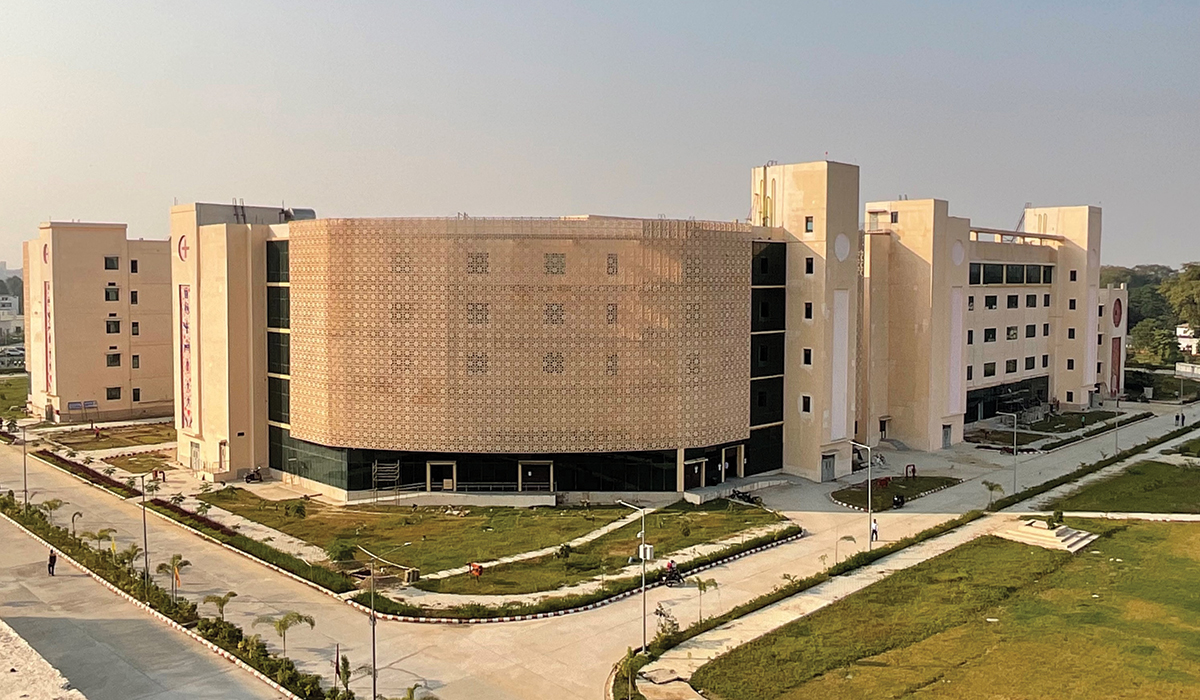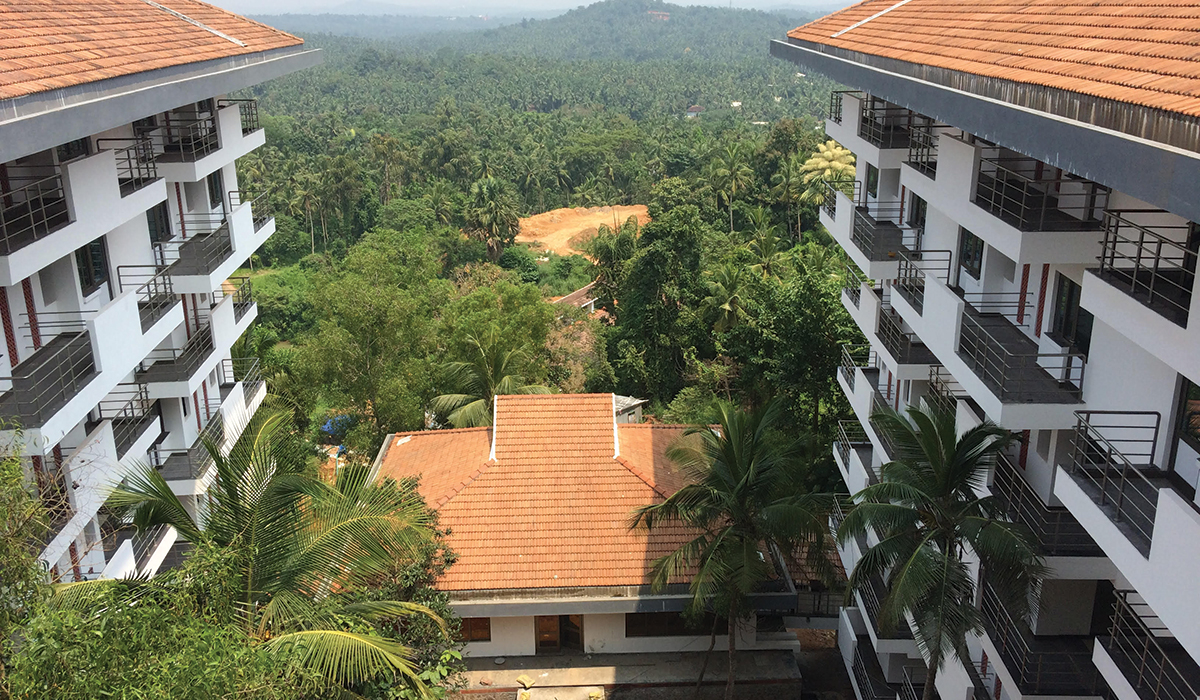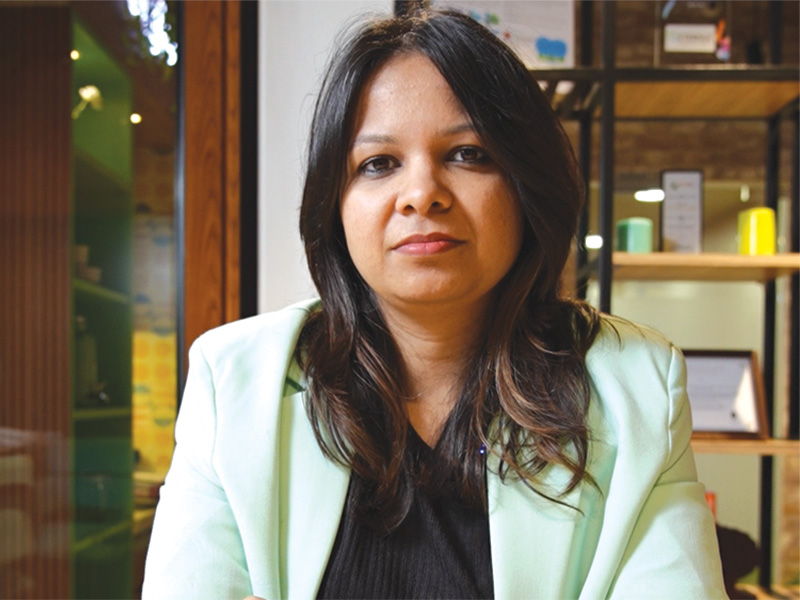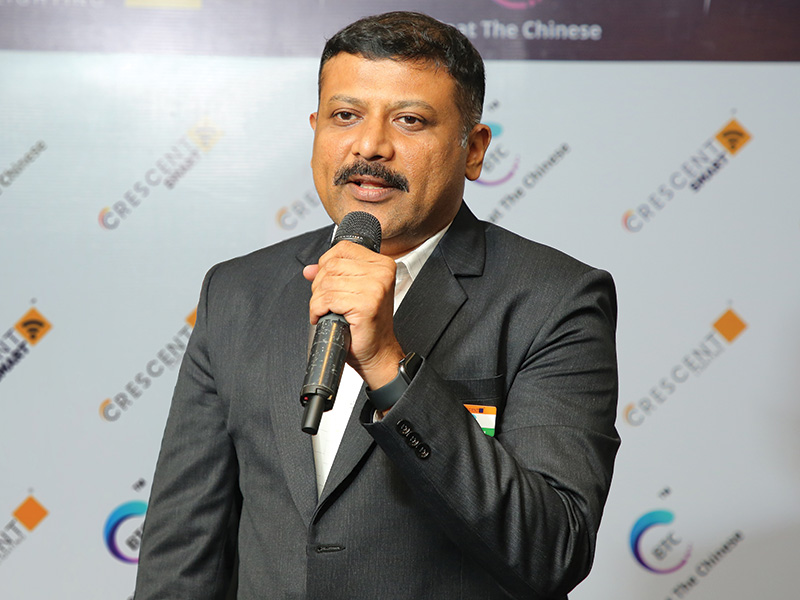Vinod Behl
We need an incentivization model to create a synergy amongst developers, architects and consumers
Shabnam Bassi
How is GRIHA catalysing green constructions in India and what new initiatives are underway or being planned to boost green construction/architecture?
Over the years, GRIHA (Green Rating for Integrated Habitat Assessment) has been developing sustainable habitats through its comprehensive environmental assessment framework. It has evolved as an effective agent for the widespread adoption of green development in India with an intent to mainstream sustainability in the built environment. Launched in 2007 as India’s own rating system, GRIHA today stands for credibility, integrity, and inclusiveness, while upholding Indian ethos for future-ready and sustainable habitats.
We have GRIHA LD (Large Developments), GRIHA for Existing Schools, GRIHA for CITIES, SVA GRIHA (Simple, Affordable, Versatile GRIHA), GRIHA AH (Affordable Housing), and GRIHA EB (Existing Buildings) along with JAN GRIHA. The rating systems are developed to holistically assess the environmental impacts and resource efficiency of new and existing buildings under diverse project scales.
Currently, the GRIHA Council has more than 3500 registered projects across the country with a combined footprint spanning more than 630 million square feet. Of these, more than 700 buildings have already been rated, under which 533 MWp of renewable energy systems installed are responsible for saving 2,97,38,818 MWh of energy, and preventing 83,93,046 tons of carbon dioxide from being released into the atmosphere every year. GRIHA rated projects have contributed to water savings of 10,36,11,250 kL/annum. More than 2,66,770 new trees have been planted and 28,000 trees have been preserved.
Since the trend of green architecture is inclined towards carbon reduction, GRIHA ratings facilitate calculation of carbon credits and enable carbon mapping through its indicators. Conforming with India’s commitment towards making the country a net zero emission nation by 2070, and based on the mantra of LiFE (Lifestyle for Environment) launched by Prime Minister Narendra Modi during COP26, the GRIHA Council has developed the GRIHA Decarbonizing Habitat Programme and India’s first Water Positive Certification. We have also designed Energy Positive, Net Zero Waste, and Lifestyle Certification to strengthen the mission and achieve our 2070 goals.
As part of our rating process, the GRIHA Council has conducted wide-ranging stakeholder-specific capacity building, awareness, and training programmes for builders, real estate developers, architects, planners, engineers, policymakers, consumers, teachers, and students.
At the global platform, the GRIHA Council has received accolades and recognition in areas such as carbon mitigation, energy efficiency, site planning, conservation, and efficient utilization of resources. India, in its Intended Nationally Determined Contributions (INDC) document submitted at COP 21 in Paris, has highlighted GRIHA as an indigenous green building rating system developed in the country. The United Nations Framework Convention on Climate Change (UNFCCC) in their third biennial update report on India has acknowledged the work done by GRIHA in the field of carbon mitigation in the building sector.
 AIIMS Gorakhpur, Uttar Pradesh
AIIMS Gorakhpur, Uttar PradeshWhat kind of synergy is there between GRIHA and global green certification bodies?
Sustainability can be achieved by incorporating global practices and embedding them in our processes and policies. The GRIHA rating system is an indigenous green building rating developed in the Indian climatic context and construction practices. It has been adopted as the national rating system for green buildings by the Government of India to reduce resource consumption, reduce greenhouse gas emissions, and enhance use of renewable and recycled resources in the built environment.
All the global certification bodies such as BREEAM, LEED, Green Star, and CASBEE have been developed with the aim to promote sustainable habitats. All these ratings are unique to their respective country’s building industry and commitments. Each rating system has some unique criterion. Largely, the GRIHA rating system looks at similar assessment criterion and practices as mentioned in the global green certification bodies.
Taking into consideration all the social, economic, and environmental aspects, and the country’s building laws, regulations and compliances, the GRIHA rating tools have been comprehensively designed to facilitate green building movement across the country at diverse project scales. Furthermore, the GRIHA certified buildings are likely to be compatible with the global standards making the Indian buildings fit for recognition and acceptance in the international market. The holistic assessment criterion of GRIHA rating tools makes it easier for the stakeholders to adapt to the national and international standards for constructing buildings in other countries.
How are the Government policies/incentives encouraging real estate developers, architects, property buyers and occupiers to opt for green constructions?
The national policies, building codes and standards have been an integral part of the GRIHA rating systems. These have been embedded in GRIHA rating assessment and verification processes. The GRIHA rating tool considers National Building Code, Bureau of Indian Standard Codes, and Energy Conservation Building Codes to ensure that the buildings are compliant to relevant codes and regulations and achieve the desired sustainability outcomes.
It also aligns with the national targets such as the Sustainable Development Goals (SDGs), National Action Plan on Climate Change (NAPCC), and National Mission on Sustainable Habitat (NMSH).
The GRIHA rating tool is an all-inclusive, comprehensive green building tool that attempts to minimize a building’s resource consumption, waste generation, carbon emission, and overall ecological impact, to within certain nationally acceptable limits / benchmarks, thereby ensuring compliance with the Government rules and building codes.
To promote green construction, the committee of secretaries made 3-star GRIHA rating mandatory for all central government buildings in 2009. The state government offers financial incentives to real estate developers for adopting green building practices and obtain GRIHA certification to promote sustainable habitat movement in India. Most of the state governments and ULBs are offering additional FAR benefit to the developers. The Union Ministry of Environment, Forest, and Climate Change (MoEFCC) issued a memorandum to facilitate fast track environmental clearance for GRIHA pre-certified projects. GRIHA certified 4- and 5-star projects would be provided financial incentives under Sunref India to project developers and home buyers.
The Uttar Pradesh government has incentivized GRIHA projects (on a plot of more than 5000 sqm and above) with free of cost 5% additional FAR for projects for complying with 4- or 5-Star GRIHA Rating in Noida and Greater Noida Area. Under SVA GRIHA rating, Pune Municipal Corporation will give discounts on the premium charges (payable to the corporation) to developers who are coming up with new construction projects in the jurisdiction, as per the star rating awarded by GRIHA Council.
The Pimpri Chinchwad Municipal Corporation (PCMC), Pune, is an exemplary case study in this regard, wherein the Corporation provides tax rebate to all the stakeholders. It has announced that the developers in PCMC will get discounts on the premium amount of building permission charges, as per the level of rating awarded by GRIHA. And, once the construction is complete, the developer will hand over the green building to the flat owners, and henceforth, the flat owners will get a discount of 10% on property tax. The Union Ministry of Urban Development announced free of cost 1% to 5% extra ground coverage and FAR for GRIHA projects.
A user-centric approach will promote market demand for green building materials and technologies
According to you, what more needs to be done, especially in terms of creating synergy among developers, architects, and the consumers?
For creating synergy among developers, architects, and consumers, a defined incentivization model needs to be developed to strengthen alliances between all the stakeholders. Since, maximum policies are developer-centric, measures such as waivers in fees for the architects at the Council of Architecture, and rebate in GST, can be included to motivate architects towards collaboration.
Incentivization models catering to the architects and consumers also need to be looked at. We need to encourage concerted efforts by all stakeholders, including the government, industries, institutional bodies, and civil society organizations to create a sustainable built environment.
Is there a strong case for immediate financial benefits for developers and property buyers/occupiers to opt for green constructions?
Many state governments have come up with policy initiatives to provide such benefits. The PCMC offers discount to developers depending on the level of SVA GRIHA star rating. For homeowners, the SVA GRIHA linked property tax benefit is in addition to the existing discounts that are offered by the Municipal Corporation - like the 10% discount to early tax payers and 10% discount for women. All residential buildings, commercial complexes, individual houses, and bungalows that comply with the SVA GRIHA criteria are eligible for rebates.
The state government of Kerala has proposed incentives on one-time building tax, stamp duties and property taxes for green buildings in the state. According to the Tamil Nadu Industrial Policy, industrial projects undertaking GRIHA rating shall be eligible for a 25% subsidy on the cost of setting up environmental protection infrastructure. The Himachal Pradesh government offers an additional 10% FAR for projects that are granted 4- and 5-star GRIHA rated buildings. The Pune Municipal Corporation announced that developers coming up with new construction projects in its jurisdiction will get discounts on the premium charges payable to the corporation, as per the star rating awarded by GRIHA Council.
The Uttar Pradesh Tourism policy prescribes reimbursement of 50% of the certification fee paid, up to Rs 10 lakh to hotel/wellness resorts obtaining Green Building Certification under GRIHA rating. The Haryana Building Code 2017 incentivizes GRIHA rated projects by awarding additional FAR of upto 15%.
While at the institutional level, a lot of efforts are being made for promoting green certifications to boost sustainable developments, not much is happening on the individual front (those who construct their own homes). Please comment.
Many efforts are being made in promoting sustainable building practices and green building certifications at the commercial and institutional levels, and slowly and steadily it is reaching the individual home spaces as well. Lack of awareness or lack of market for green infrastructure is the main reason for a slow uptake of sustainable practices at individual home levels.With increased awareness on environment and climate change, people will be motivated and show interest in building their homes that are sustainable, environment-friendly and reduce their carbon footprint significantly. For the individual homeowners, the GRIHA Council developed a unique GRIHA certification programme known as JAN GRIHA (Jan Awas Nirman GRIHA) and GRIHA rating variant known as SVA GRIHA (Simple, Versatile, Affordable GRIHA). These two GRIHA variants are designed primarily to assess the resource efficiency and environmental impact of individual homes in a holistic manner.
SVA GRIHA was conceived to spread the concept of green buildings and sustainability to small-scale stakeholders, that is, owners of projects such as bungalows and small offices. It was developed as a simple guidance-cum-rating tool to ramp up its adoption by general masses and further minimize the GHG emissions caused by small-scale constructions.The GRIHA Council launched JAN GRIHA certification to align ourselves to the Pradhan Mantri Awas Yojna (PMAY). This certification caters to the smaller low-cost residential buildings in India with an aim to spread the idea of sustainability at grassroot level, recognize the small efforts made by low-income group people towards sustainability and encourage them to adopt modifications in their choices to lower their carbon footprint.
Building materials and technology also play a crucial role in creating a green infrastructure. To facilitate the construction of green infrastructures, the GRIHA Council has also launched the GRIHA Product Catalogue which enlist the product and systems that are compliant to green building codes and regulations. The GRIHA Product Catalogue aims at creating a database of the products and technologies that will strengthen resource efficiency of the building.
Along with this, a multi-pronged approach which includes awareness campaigns, training workshops, financial incentives from the government such as tax rebates, low interest loans, subsidies on green building materials and technologies and incentivization of green buildings are some ways to expand green building movement across diverse landscapes.
Mandating green ratings requires a multi-faceted approach that will require a robust implementation framework along with strong policies at the ULB level
Should there be a mandatory rating of real estate developers /architects on the basis of green developments?
With climate change impacts becoming evident day by day, green building sector is gaining prominence. To encourage green building practices, first and foremost it is crucial to recognize the gaps and challenges faced by various stakeholders during construction, design, or operation of green buildings. Based on that capacity building and information, dissemination programmes have to be conducted for the stakeholders to impart knowledge and guide them through the processes. Apart from this, policies need to be strengthened to increase adoption of the green buildings.
Based on a user-centric approach, as consumers become aware of the benefits of green buildings, an increase in demand for sustainable infrastructure will be gained. Further, this will enhance and promote market demand for green buildings, building materials and technologies. Subsequently, it will become important to ensure availability of green products at affordable rates to the stakeholders. Capacity building programmes will help to create a cadre of professionals for sustainable development.
The GRIHA Council offers a wide range of stakeholder-specific capacity building and training programmes and has successfully trained more than 20,000 students and professionals across India.
Mandating green ratings is not a standalone step. It requires a multi-faceted approach that will need a robust implementation framework along with strong policies at ULB levels.
 IIM Kozhikode
IIM KozhikodeWhat according to you are challenges and prospects before the growth of green buildings in India?
Conventionally, sustainability has been the foundation of our construction practices. Our traditional knowledge has been centred around living in harmony with nature. Increased exposure and emphasis on aping the West has somewhere affected our choices. In order to get back to our roots and strengthen existing construction practices, the Central government has introduced many initiatives such as Vocal for Local, Make in India and the recent LiFE Mantra announced at COP26. All these programmes are focussed on encouraging and promoting individual and community action to protect and preserve the environment and practise a lifestyle that is synchronous with nature.
GRIHA focus is on using locally available products and materials. The rating systems have been designed holistically to assess the environmental impacts of the buildings and strike a balance between the established practices and emerging concepts. Some of the areas that can be strengthened for promoting green buildings in India include:
- Lack of Awareness: A lot of challenges are around the most basic fact, i.e. lack of awareness. There are a lot of professionals, working in the green building industry and the industry is only ever-growing. However, it is still considered a niche segment. Green buildings are still considered as a separate category of projects rather than it being the standard.
- Wrong notions like higher costs, more paperwork & “extra” effort: Another constraint is the notion around green buildings and misconceptions among people. Many think implementation of green buildings, is an additional effort that they must take over and above constructing a normal building. But it is about the “right” effort and not “extra” effort. People are yet to comprehend that it is more about choosing the right alternatives than bringing in anything new.
- Dissociation with concept of payback: Payback benefits generally incur an additional initial higher cost and have a time span for the ROI, before consumers can actually reap the benefits. So, it is difficult to get through to people in explaining why they must pay more now, to get intangible benefits a few years later.
- Acceptability of new trends: The market is not very quick to adapt to new trends. It had taken ECBC over a decade to get it notified in 15 states. Its implementation is yet to properly take off in most of these states.
However, witnessing the commitments made by the Government of India towards 2070, the prospects of sustainable habitats are promising in India. Since the impacts of climate change are fast changing, it is crucial to focus on holistic approach for green infrastructures that are climate resilient. Our vision should address the challenges of next 40 years and that how we can contribute through habitat as a robust adaptation and mitigation strategy.
















